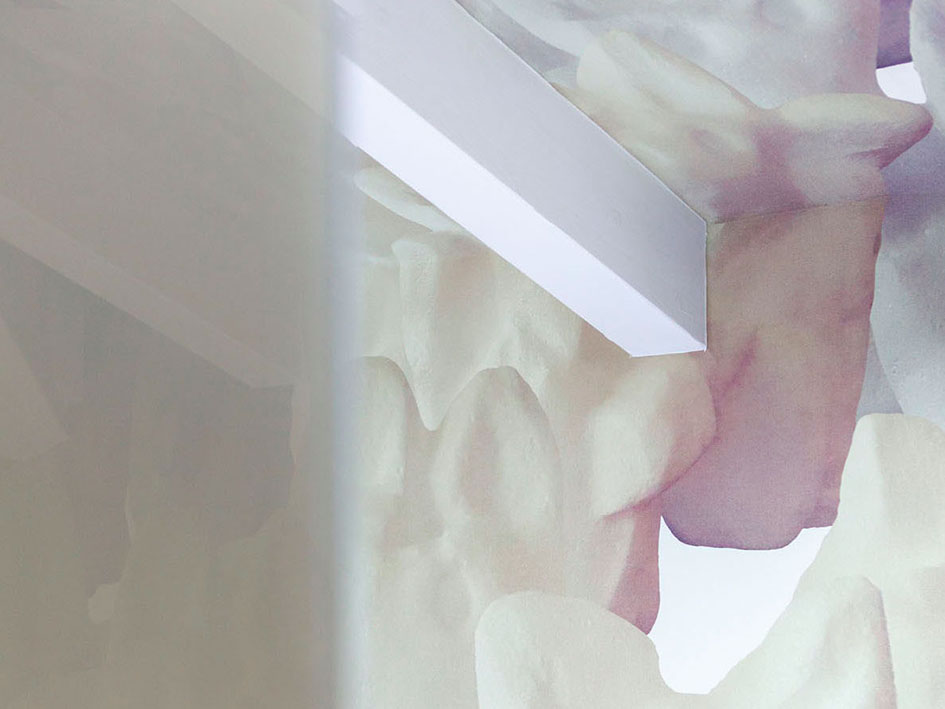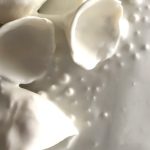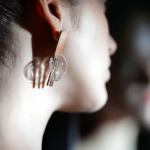LORO siamo NOI, per gli altri
Æ — Riccardo Previdi, artista con la capacità di portare ricerca e cultura fuori dalla sfera propriamente dedicata all’arte. Probabilmente la vicinanza con il mondo dell’architettura da cui provieni come studi e come environment familiare ha addestrato in te l’abitudine e la capacità a guardare lo spazio fisico, abitabile, gli ambienti quali materiale con cui dialogare e produrre arte.
RP — I miei studi, Liceo Artistico prima, Accademia di Belle Arti e Architettura al Politecnico di Milano poi, hanno sicuramente influenzato il mio modo di vedere le cose. Alberto Garutti, con una formazione da architetto e una cariera da artista e Corrado Levi, archietetto, artista (e curatore, collezionista, savateur… aggiungerebbe lui), sono stati i miei insegnati. Anche Carol Rama, ospite fissa ai corsi di Corrado Levi ha svolto un ruolo importante.
In casa, lo studio di architettura di mio padre è stato per mio fratello (che ora ci lavora) e me, sin da molto piccoli, una specie di playground e più avanti, anche grazie all’apertura al suo interno dello spazio espositivo Spazio Lima lo è stato anche per tanti amici e colleghi, milanesi e non. Anche mia madre ha avuto un ruolo importante, con il suo interesse per la cucina (macrobiotica) e il design (i workshop sartoriali per bambini di Franco Mazzieri e quelli pedagogici di Bruno Munari). Aldilà della mia storia personale però, credo che le incursioni dell’architettura nell’arte siano comuni a molti artisti italiani. Come ricorda Giò Ponti nel suo libro Amate l’architettura: quando chiese all’autista parigino di Tony Bouilhet, come trovava l’Italia: « très architecturale » fu la risposta che ottenne.
Æ — Un elemento importante della tua ricerca artistica che mi affascina particolarmente è la capacità di iniettare l’arte nella vita quotidiana. Parti da essa e ritorni ad essa trasformandola in opera, sintetizzando nel tuo lavoro delle dinamiche tipiche di un contesto storico e sociale.
Non ti fermi alla sola proposizione dell’opera ma cerchi l’interazione con chi la guarda e la vive. Il wallcovering “LORO” nasce con questa intenzione.
Cosa ne pensi a riguardo?
RP — I prelievi dal quotidiano, dal paesaggio che ci circonda sono sempre stati una costante nel mio lavoro.
Penso che l’osservazione attenta di quanto ci sta attorno e dei meccanismi più o meno nascosti che azionano le dinamiche sociali siano da sempre la cosa che più mi interessa in un lavoro artistico, e non solo.
Penso che uno dei compiti dell’arte sia mettere in luce le contraddizioni, formulare domande astenendosi dal dare facili risposte.
Penso che il processo sia la cosa più interessante. Non tanto l’output, quello è un pretesto, quanto piuttosto il percorso che si fa per arrivarci.
Penso che in questo l’arte dei graffiti ai suoi albori, così come l’uso che si è fatto del campionatore nella musica hip-hop e nella musica elettronica abbiano anche giocato un ruolo importante.
Rendere più visibili certi segni o fenomeni, lasciando che sia il pubblico a costruirsi un modo per decodificarli per dare loro un senso, è il mio modo di intendere il lavoro.
LORO nasce da questa presa di coscienza. Dalla volontà di non voler percorrere scorciatoie (oggi più che mai, col proliferare di comodi populismi). LORO Nasce da una scansione 3D di tre gattini Maneki Neko fatti senza pensare, in pochi minuti, da me con della pasta per modellare DAS. LORO registra il limiti tecnici nelle partiche del modellare della mia persona e i salti da gignate che sta facendo la tecnica a questo riguardo. LORO è uno scatto al photo-finish del passaggio di testimone dall’uomo alla macchina, dalla nostra intelligenza a quella artificiale. Un passaggio, non privo di frizioni. Ma LORO è anche un esercito di “altri”….
I prelievi dal quotidiano, dal paesaggio che ci circonda
sono sempre stati una costante nel mio lavoro.
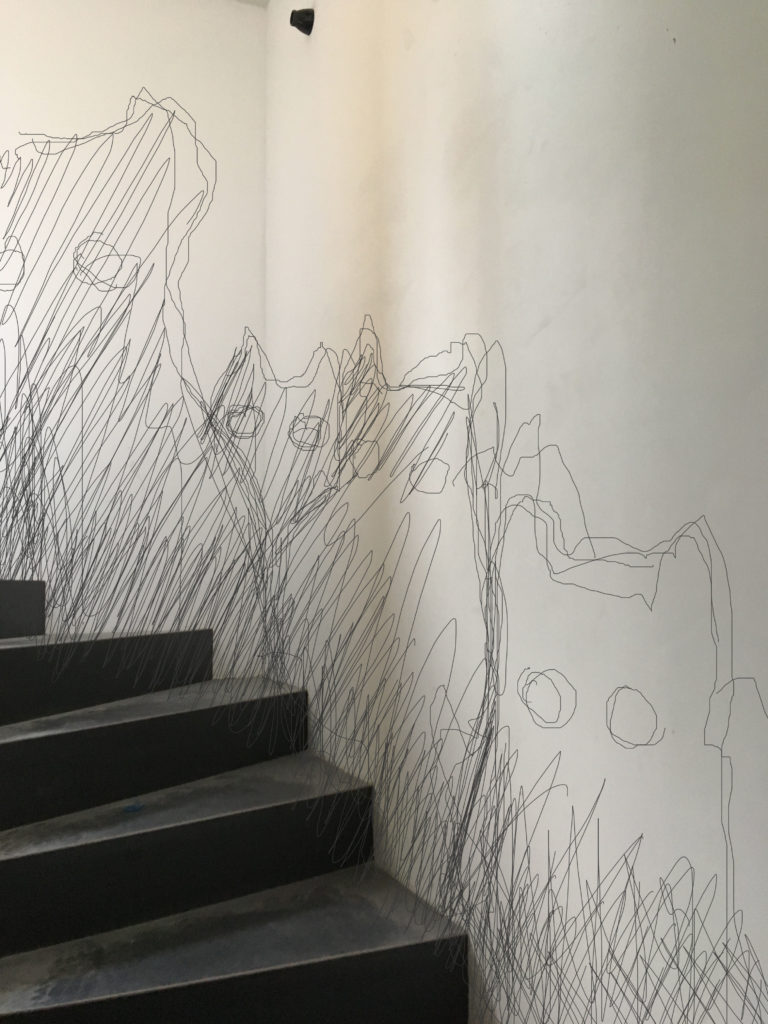
Progetto LORO, courtesy dell’artista
Æ — Chi sono “LORO”?
RP — LORO sono gli “altri”, quelli che la pensano diversamente da noi, quelli che stanno dall’altra parte del muro, del mare, del globo. LORO siamo NOI, per gli altri.

Progetto LORO, courtesy dell’artista
Æ — Marco Tagliafierro, curatore, critico e giornalista oltre che nostro comune amico che ci ha fatto incontrare, ti ha descritto come uno dei più significativi “artisti funzionali” . Ti ritrovi in questa definizione?
RP — Capisco cosa intende, e in parte sono d’accordo. Bisogna stare attenti però, io per primo ovviamente, a che una disponibilità di partenza e un complessivo senso di apertura che il mio lavoro porta con se, non siano seguiti da una subordinazione del fare artistico a secondi fini. Funzionalista si, a patto che l’arte non diventi applicata.
Æ — L’opera di un’artista, se di valore, evolve sempre, alle volte rimanendo anche uguale a sé stessa ma con dei particolari fondamentali che ne fanno cambiare natura, forma e quotazione. L’abbiamo vissuto da poco, LORO, il wallcovering sviluppato per la collezione CARTE, è diventato una tela, un pezzo unico, un’opera d’arte. Come spieghi questo processo a chi non consce e logiche che sottendono l’arte contemporanea?
RP — Non saprei. Direi che questa evoluzione è insita nelle cose e più nello specifico nel mio modo di procedere. Pur lavorando io principalmente a progetto, l’attività in atelier ha sempre accompagnato la mia ricercerca. I progetti con le loro scadenze e i loro vincoli, producono sempre del materiale in “esubero”. Cose che si scartano all’ultimo perché magari non rispondo appieno alle esigenze della particolare circostanza. Queste cose, spesso generano nuove riflessioni, approfondimenti, sguardi alternativi. LORO da wallcovering, carta da parati, si trasforma, dopo aver accolto una piccola ma importante modifica, in una grande tela, montata su un telaio di alluminio. Da lavoro “al metro” a pezzo unico.
D’altra parte, a 84 anni dalla prima edizione de: “L’opera d’arte nell’epoca della sua riproducibilità tecnica” di Walter Benjamin, non dovrebbe più esserci nessuna (o quasi) differenza tra unico e riproducibile, l’aura malgrado tutto, non dovrebbe più essere il punto. Quindi direi che un lavoro vale l’altro, la natura cambia, la diponibilità in numero pure, ma non certo il senso; la ragione per cui un lavoro è stato concepito resta la stessa.
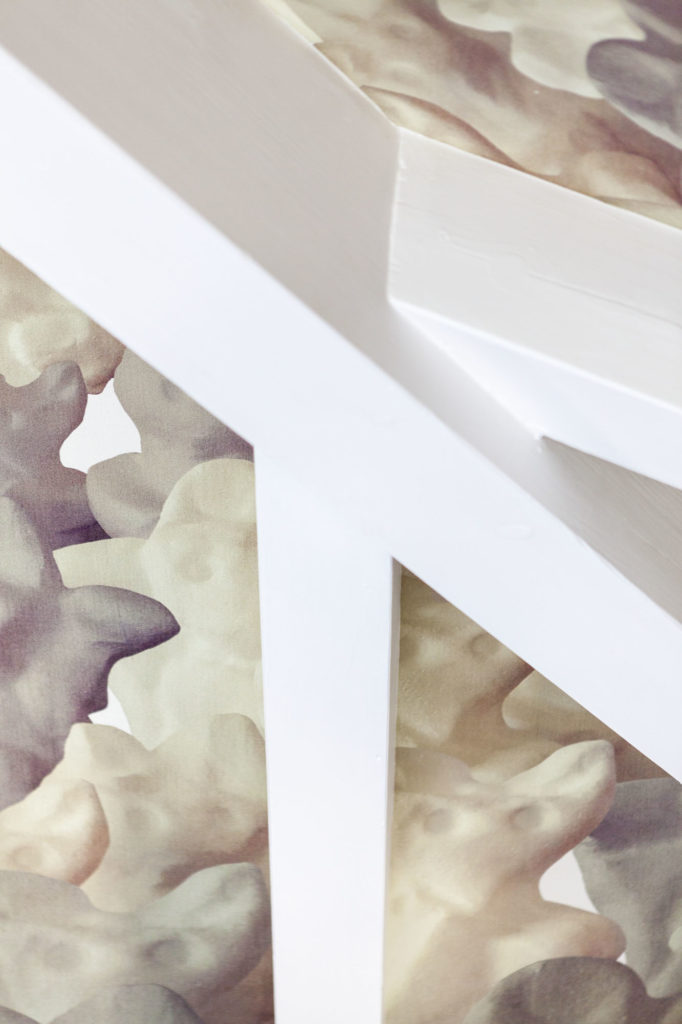
LORO Wallpaper by Riccardo Previdi @ Casa Trentini ; ph : Cristina Galliena Bohman
Æ — Toccando la tematica dei materiali e della rinnovata ricerca che oggi gli artisti spendono nell’ingadare le possibilità della materia, grazie al lavoro pluriennale di Samantha con diverse realtà legate al vetro di Murano, la vicinanza con il tema è tale da spostare anche il mio sguardo e ricerca verso artisti e progetti che desiderano sperimentare la magia del vetro soffiato trasformandolo in opera d’arte. Tu hai mai avuto delle esperienze in fornace in passato?
RP — Non ho mai avuto l’occasione di confrontarmi con una fornace. Con il vetro ho gia lavorato, ma utilizzandolo in lastre, partendo quindi da un semilavorato. La fornace mi incuriosisce molto. Mi incuriosiscono sempre di più quelle tecnologie che sono a cavallo tra l’industriale e l’artigianale. Come nel caso di NOI, il gruppo scultoreo realizzato durante la residenza alla Giovanrdi. Mi interessa il punto in cui macchina e uomo si passano il testimone. Quando una progettazione rigorosa sfocia nella casualità, si imbatte nell’errore tecnico come anche nell’accellerazione data da una particolare eccellenza.
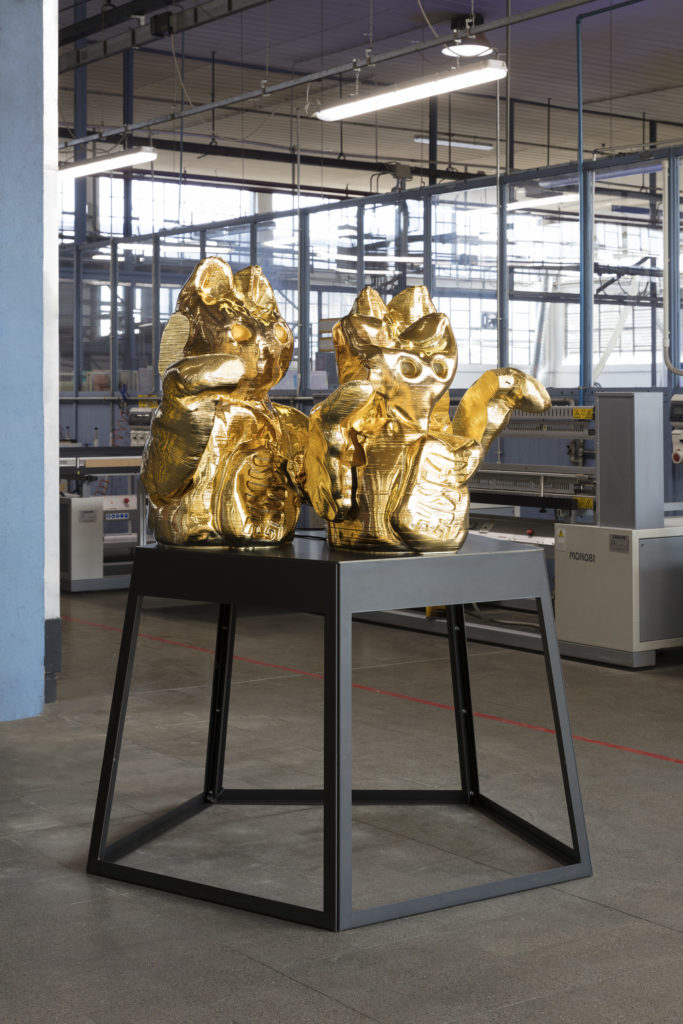
NOI @ Giovanardi ; ph : Andrea Rossetti
Æ —Milano, Berlino, Merano e ora Zurigo, se non ho tralasciato delle tappe, posso riassumere così la tua road map esistenziale. Zurigo è una città in cui la cultura marcia implacabile spinta da un economia florida e da un’educazione sociale molto elevata. Quali le tue prime impressioni? Qualche aspettativa?
RP — A Zurigo sono arrivato questa estate. La città la conoscevo già, non solo per le gallerie e per la Kunsthalle, luogo in cui, nel corso degli anni, ho visto alcune delle più belle mostre che io abbia mai visto. Ora con l’attuale situazione esplorare la citta e allargare il giro di conoscenze non è semplicissimo, ma sono sicuro che col tempo finiremo per sentirci di casa anche qui.
Æ — In conclusione, Il tuo pensiero sull’arte contemporanea oggi, quali conseguenze positive e negative a seguito agli stravolgimenti sociali, economici, sanitari e culturali di questi ultimi mesi?
RP — Uh questa è una domandona! a rispondere troppo seriamente si rischia di dire delle gran castronerie… Malgrado ciò, ci proverò ugualmente. L’arte, per come la intendiamo noi occidentali, c’è sempre stata, in periodi di carestia così come in quelli di fertilità, è stata al servizio del potere, anche quando questo era tutt’altro che democratico o “giusto” ritagliandosi sempre spazi per poterlo anche criticare, se non addirittura mettendolo in discussione alla radice… Immagino che anche per il prossimo futuro, continuerà ad essere così, il suo ruolo continuerà ad essere quello di sempre. Tra l’incudine e il martello, cercando di ritagliarsi spazi dove possibile, saccheggiando, guardando dietro le quinte osservando e facendoci osservare parte dei meccanismi che stanno dietro le cose che ci circondano… oppure, ma questo è più difficile, trascendendo, generando uno scarto facendo finalmente comparire l’altro.
***
LORO are we, for others
Æ — Riccardo Previdi, an artist with the ability to bring exploration and culture out of the purely artistic sphere.
Probably your closeness to the world of architecture, which comes through your studies and through your family environment, trained you in the habit and the ability of looking at the physical, habitable space, the surroundings, as material with which to converse and produce art.
RP — My studies, first at Artistic High School, then the Academy of Fine Arts and Architecture at the Polytechnic of Milan, have certainly influenced my way of seeing things. Alberto Garutti, with both training as an architect and a career as an artist, and Corrado Levi, architect, artist (and curator, collector, savateur … he would add), were my teachers. Carol Rama, a regular visitor to Corrado Levi’s courses, also played an important role
At home, my father’s architecture studio was a kind of playground for my brother (who now works there) and for me, from a very early age, and later, also thanks to the opening of the Spazio Lima exhibition space within it, it was the same for many friends and colleagues, both from Milan and elsewhere. My mother also played an important role, with her interest in cooking (macrobiotic) and design (Franco Mazzieri’s tailoring workshops for children and Bruno Munari’s pedagogical workshops). Beyond my personal history, however, I believe that the forays of architecture into art are common to many Italian artists. As Giò Ponti recalls in his book Love Architecture: when he asked Tony Bouilhet’s Parisian driver how he found Italy: “très architecturale” was the response.
Æ —An important element of your artistic inquiries that particularly fascinates me is the ability to inject art into daily life. You start from itand return to it transforming it into a work, synthesizing in your work the typical dynamics of a historical and social context.
You do not stop at merely creating the work, but seek interaction with those who look at it and live it. The “LORO” wall-covering originated with this intention. What do you think about it?
RP — Taking from everyday life, from the landscape that surrounds us, has always been a constant in my work.
I think that the careful observation of what is around us and the more or less hidden mechanisms that drive social dynamics have always been the thing that interests me most, in an artistic work but not in that alone.
I think that one of the tasks of art is to highlight contradictions, formulate questions while refraining from giving easy answers.
I think the process is the most interesting thing. Not so much the output, that is a pretext, but rather the way you choose to arrive there.
I think that the art of graffiti in its early days, as well as the use made of the sampler in hip-hop and electronic music, have also played an important role in this.
Making certain signs or phenomena more visible, letting the public build a way of decoding them to give them meaning, is my way of understanding work.
LORO (THEY) comes from this awareness. From the desire not to take short cuts (now more than ever, with the proliferation of convenient populism). LORO was born from a 3D scan of three Maneki Neko kittens made by me without thinking, in minutes, with DAS modelling paste. LORO records the technical limits in the details of my personal modelling and the leaps and bounds of the technique in this regard. LORO is a photo-finish shot of the passing of the baton from man to machine, from our intelligence to the artificial one. A passage, not without friction. But LORO is also an army of “others”….
Taking from everyday life, from the landscape that surrounds us, has always been a constant in my work.
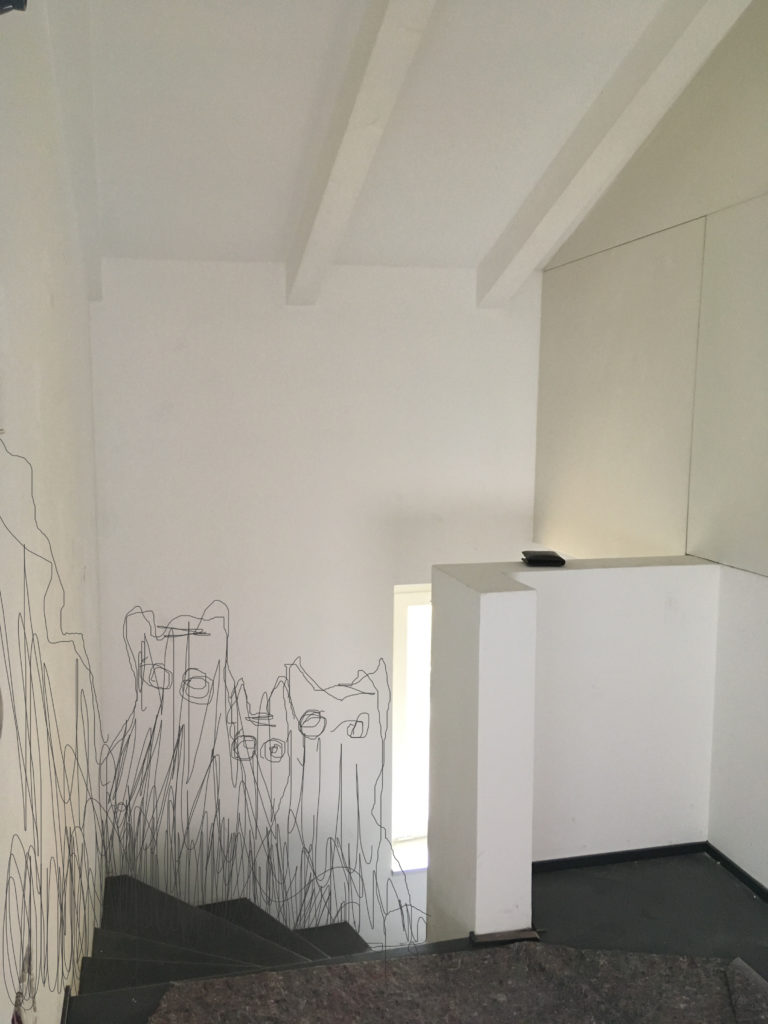
Æ — Who are “LORO”?
RP — LORO are the “others”, those who think differently from us, those who are on the other side of the wall, of the sea, of the globe. LORO are WE, for others.
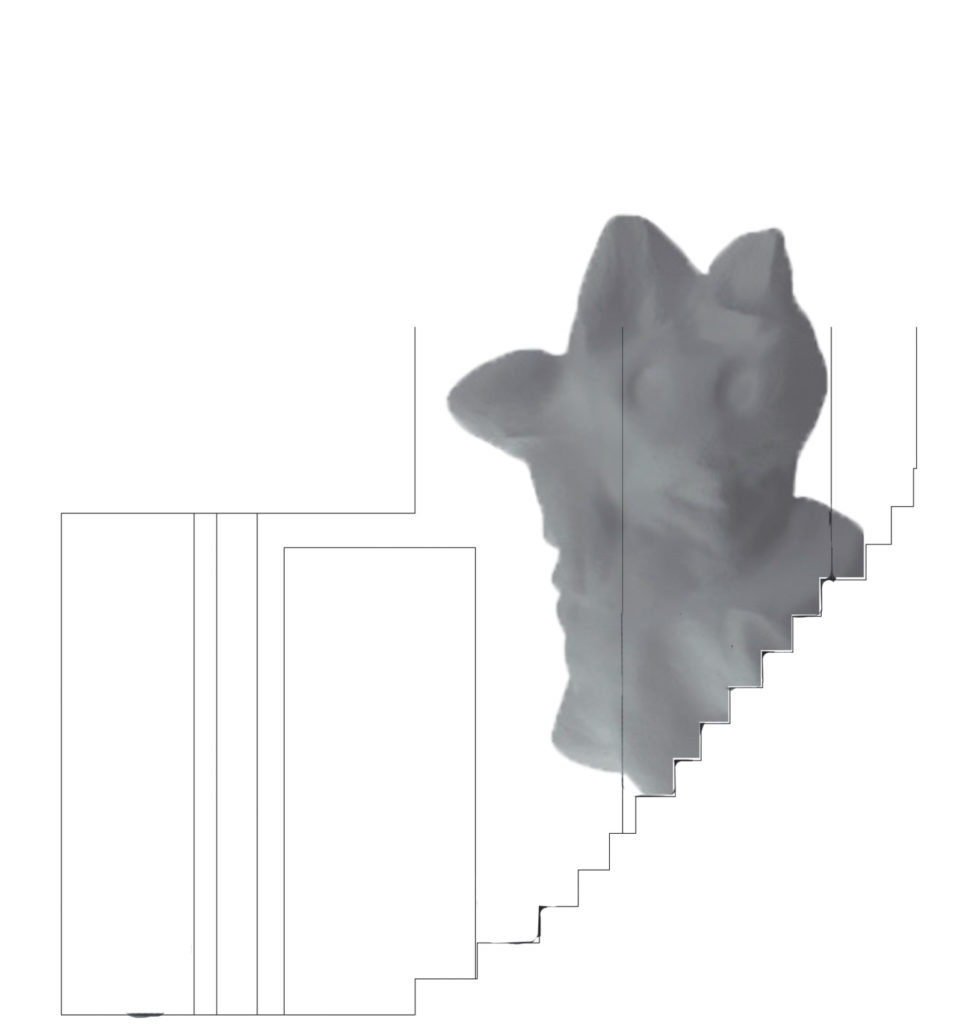
LORO project, courtesy of the artist
Æ — Marco Tagliafierro, curator, critic and journalist as well as our mutual friend who brought us together, described you as one of the most significant “functional artists”. Do you find yourself in this definition?
RP — I understand what he meant, and in part I agree. One has to be careful though, I for one course, to an readiness to begin and the overall sense of openness that my work brings with it, are not followed by a subordination of the making of art to ulterior motives. Functionalist yes, as long as the art does not become applied.
Æ — The work of an artist, if of value, always evolves, sometimes remaining constant but with fundamental details that make it change its nature, shape and value. We have recently experienced the way in which LORO, the wall-covering developed for the CARTE collection, has become a canvas, a unique piece, a work of art.
How do you explain this process to those unfamiliar with the logic behind contemporary art?
RP — I don’t know. I would say that this evolution is inherent in all things and more specifically in my way of proceeding. Although I work mainly on projects, activity in the studio has always run alongside my investigations. Projects, with their deadlines and constraints, always produce “surplus” material. Things that are discarded at the last minute because perhaps they do not fully respond to the needs of the particular circumstances. These things often generate new reflections, insights, alternative visions. LORO is transformed from a wall-covering, a wallpaper, after taking a small but important modification, into a large canvas, mounted on an aluminium frame. From work “by the metre” to a unique piece.
On the other hand, 84 years after the first edition of “The Work of Art in the Age of Mechanical Reproduction” by Walter Benjamin, there should no longer be any (or almost any) difference between what is a unique piece and what can be reproduced, the aura, in spite of everything, should no longer be the point… So I would say that one job is as good as another, the nature of it changes, the number available as well, but certainly not the meaning; the reason a job was conceived remains the same.
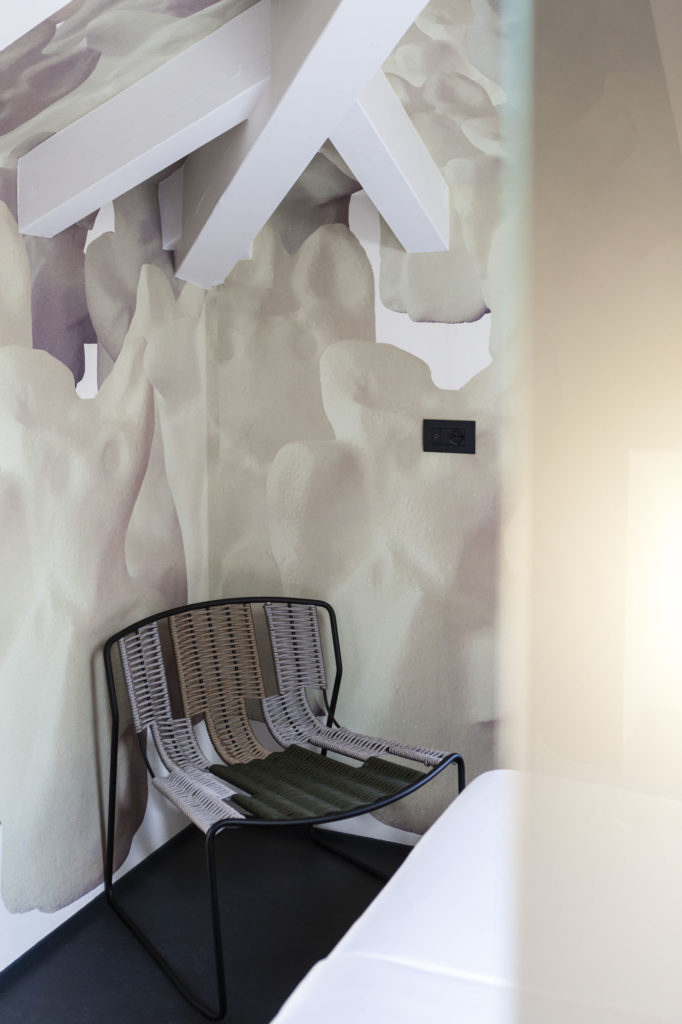
LORO Wallpaper by Riccardo Previdi @ Casa Trentini ; ph : Cristina Galliena Bohman
Æ — Touching on the theme of materials and the renewed pursuit of today in encroaching on the possibilities of matter, thanks to Samantha’s work over a number of years with various entities related to Murano glass, the closeness to the theme is such as to shift my gaze and my research towards artists and schemes who wish to experience the magic of blown glass, transforming it into a work of art.
Have you ever had experiences in the furnace in the past?
RP — I have never had the opportunity to be face-to-face with a furnace. I have previously worked with glass, but using it in sheets, starting from a semi-finished product. The furnace intrigues me greatly. I am more and more curious about those technologies that straddle the industrial and the artisanal. As in the case of NOI, the sculptural group created during my residency at Giovanrdi. I’m interested in the point at which man and machine pass the baton. When a rigorous design flows into randomness, it encounters both technical error and the acceleration given by a particular excellence.

NOI @ Giovanardi ; ph : Andrea Rossetti
Æ — Milan, Berlin, Merano and now Zurich, if I have not missed some stages, can sum up your existential road map. Zurich is a city where the relentless march culture is driven by a thriving economy and a very high social education. What are your first impressions? Some expectations?
RP — I arrived in Zurich this summer. I already knew the city, and not only for the galleries and the Kunsthalle, a place where, over the years, I have seen some of the most beautiful exhibitions I have ever seen. Now with the current situation, exploring the city and expanding one’s circle of acquaintances is not easy, but I’m sure that over time we will end up feeling at home there too.
Æ — In conclusion, your thoughts on contemporary art today, such as the positive and negative consequences following the social, economic, health and cultural upheavals of recent months?
RP — Uh this is a big question! To respond too seriously risks talking a lot of nonsense … Nevertheless, I’ll try anyway. Art, as we Westerners understand it, has always been there, in times of scarcity as well as in those of plenty, it has been at the service of power, even when this was anything but democratic or “right”, yet always carving out spaces for being able to criticize it, if not even questioning it at its root… I imagine that for the foreseeable future it will continue to be so, its role will continue to be the same as always. Between a rock and a hard place, trying to carve out spaces where possible, ransacking, looking behind the scenes by observing and making us observe part of the mechanisms behind the things that surround us… or, but this is more difficult, transcending, generating a margin by making the Other finally appear.
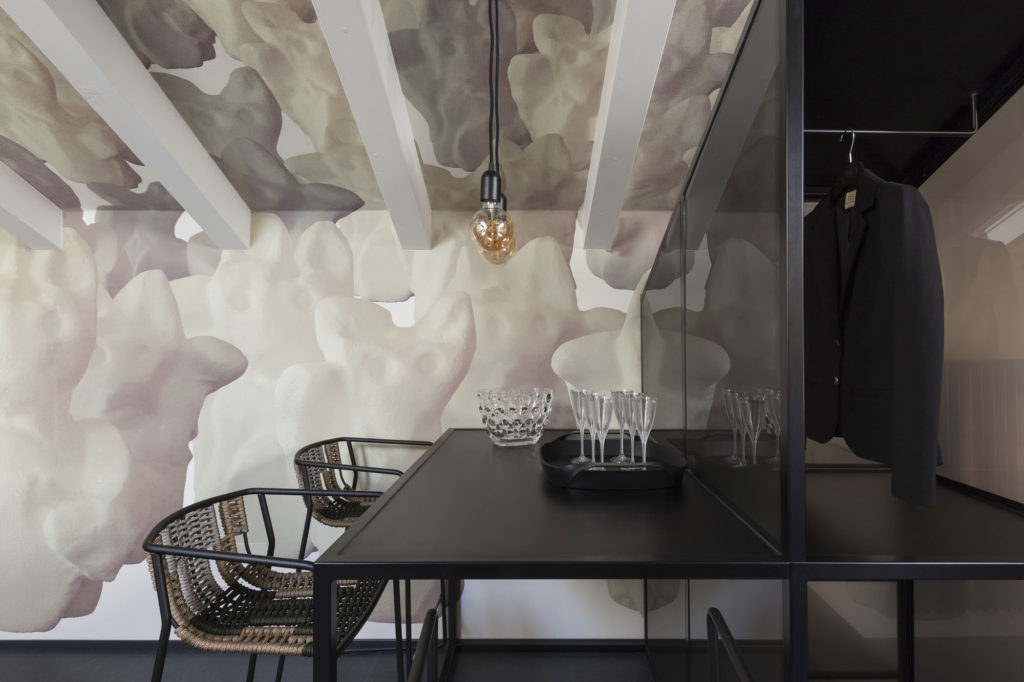
LORO Wallpaper by Riccardo Previdi @ Casa Trentini ; ph : Cristina Galliena Bohman

